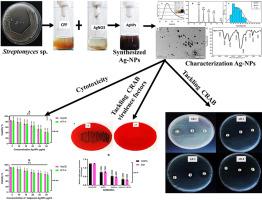生物合成纳米银与亚胺培南联合处理耐碳青霉烯鲍曼不动杆菌及其毒力因子
引用次数: 0
摘要
耐碳青霉烯鲍曼不动杆菌是一种极其危险的微生物,因为它对多种抗生素具有高度耐药性,使其成为一个重大的公共卫生问题。本研究旨在利用链霉菌(Streptomyces sp.)衍生的无细胞过滤器生物制备纳米银,重点研究其物理化学性质,并利用其对抗螃蟹及其毒力因子。通过TEM分析证实,生物制备的Ag-NPs主要为球形,平均尺寸为50 nm,而DLS测量显示其平均水动力直径约为36.78 nm。紫外可见光谱显示,表面等离子体共振峰在420 nm范围内,表明纳米颗粒形成。XRD证实其晶体结构为面心立方银。FTIR光谱显示,链霉菌无细胞过滤器衍生的代谢物化合物积极参与还原和稳定过程。使用Vitek-2系统鉴定8株临床分离细菌为CRAB,通过刚果红和微孔板检测100%的生物膜形成情况。Ag-NPs和亚胺培南(IMP)的MIC分别为4 ~ 5 μg/mL和13 ~ 15 μg/mL。此外,Ag-NPs和IMP协同组合的分数抑制浓度指数(FICI)在0.5 ~ 0.375之间,表明IMP和Ag-NPs的MIC值分别从14和5 μg/mL显著降低到1.75和1.25 μg/mL。qRT-PCR结果显示,Bap和ompA基因的表达水平显著降低了4.0倍(p≤0.001)。时间杀伤实验证实,Ag-NPs与IMP的协同作用可有效杀灭该菌株,细胞毒性评价显示Ag-NPs与IMP联用毒性较低,IC50分别为26.13±0.24和45.33±0.21 μg/mL (p <;0.0019),生物安全性较好,12 h和24 h溶血率分别为0.4和0.7。我们的结论是Ag-NPs与IMP的联合治疗可能是一种有希望的治疗螃蟹的替代策略。本文章由计算机程序翻译,如有差异,请以英文原文为准。

Tackling carbapenem-resistant Acinetobacter baumannii (CRAB) and their virulence factors using biosynthesized silver nanoparticles combined with imipenem
Carbapenem-resistant Acinetobacter baumannii is an extremely hazardous microorganism due to its high level of resistance to a wide array of antibiotics, making it a significant public health concern. Herein, this study aimed to biofabricate silver nanoparticles using a cell-free filter derived from Streptomyces sp., with a focus on characterizing their physicochemical properties, and use them to combat CRAB and their virulence factors. The biofabricated Ag-NPs were predominantly spherical with an average size 50 nm, confirmed through TEM analyses, while DLS measurements showed an average hydrodynamic diameter of approximately 36.78 nm. UV–Vis spectroscopy displayed a characteristic surface plasmon resonance peak in the range of 420 nm, indicative of nanoparticle formation. XRD confirmed the crystalline structure, presenting peaks corresponding to face-centered cubic silver. FTIR spectroscopy revealed active participation of metabolite compounds derived from the Streptomyces cell-free filter in both reduction and stabilization processes. Eight clinical bacterial isolates were identified as CRAB using the Vitek-2 system, and biofilm formation with 100 % was assessed through Congo red and microplate assays. The MIC for Ag-NPs and imipenem (IMP) were found to be between 4 and 5 μg/mL and 13 and 15 μg/mL, respectively. Additionally, the fractional inhibitory concentration index (FICI) for the synergistic combinations of Ag-NPs and IMP ranged from 0.5 to 0.375, indicating a notable decrease in the MIC values for both IMP and Ag-NPs from 14 and 5 μg/mL to 1.75 and 1.25 μg/mL, respectively. The qRT-PCR demonstrated a significant reduction in the expression levels of the Bap and ompA genes by up to 4.0-fold (p ≤ 0.001). The time-killing assay confirmed that the bacterial strain was effectively eliminated through the synergistic action of Ag-NPs and IMP. Moreover, the cytotoxicity assessment of Ag-NPs and their combination with IMP revealed low toxicity of the combination of Ag-NPs and IMP, with an IC50 of 26.13 ± 0.24 and 45.33 ± 0.21 μg/mL, respectively (p < 0.0019), indicating good biosafety, while the hemolysis rates were recorded at 0.4 and 0.7 at 12 and 24 h, respectively. We concluded that the combination of Ag-NPs with IMP could serve as a promising alternative strategy for treating CRAB.
求助全文
通过发布文献求助,成功后即可免费获取论文全文。
去求助

 求助内容:
求助内容: 应助结果提醒方式:
应助结果提醒方式:


